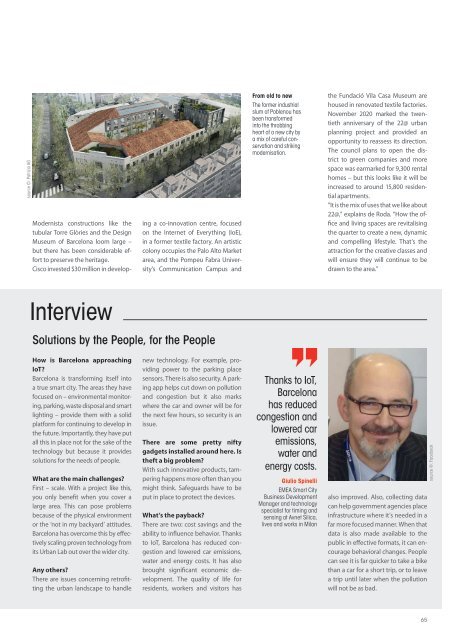Smart Industry No.1 2022
Smart Industry No.1 2022 - The IoT Business Magazine - powered by Avnet Silica
Smart Industry No.1 2022 - The IoT Business Magazine - powered by Avnet Silica
You also want an ePaper? Increase the reach of your titles
YUMPU automatically turns print PDFs into web optimized ePapers that Google loves.
source ©: Patrizia AG<br />
Modernista constructions like the<br />
tubular Torre Glòries and the Design<br />
Museum of Barcelona loom large –<br />
but there has been considerable effort<br />
to preserve the heritage.<br />
Cisco invested $30 million in developing<br />
a co-innovation centre, focused<br />
on the Internet of Everything (IoE),<br />
in a former textile factory. An artistic<br />
colony occupies the Palo Alto Market<br />
area, and the Pompeu Fabra University's<br />
Communication Campus and<br />
From old to new<br />
The former industrial<br />
slum of Poblenou has<br />
been transformed<br />
into the throbbing<br />
heart of a new city by<br />
a mix of careful conservation<br />
and striking<br />
modernisation.<br />
the Fundació Vila Casa Museum are<br />
housed in renovated textile factories.<br />
November 2020 marked the twentieth<br />
anniversary of the 22@ urban<br />
planning project and provided an<br />
opportunity to reassess its direction.<br />
The council plans to open the district<br />
to green companies and more<br />
space was earmarked for 9,300 rental<br />
homes – but this looks like it will be<br />
increased to around 15,800 residential<br />
apartments.<br />
“It is the mix of uses that we like about<br />
22@,” explains de Roda. “How the office<br />
and living spaces are revitalising<br />
the quarter to create a new, dynamic<br />
and compelling lifestyle. That’s the<br />
attraction for the creative classes and<br />
will ensure they will continue to be<br />
drawn to the area.”<br />
Interview<br />
Solutions by the People, for the People<br />
How is Barcelona approaching<br />
IoT?<br />
Barcelona is transforming itself into<br />
a true smart city. The areas they have<br />
focused on – environmental monitoring,<br />
parking, waste disposal and smart<br />
lighting – provide them with a solid<br />
platform for continuing to develop in<br />
the future. Importantly, they have put<br />
all this in place not for the sake of the<br />
technology but because it provides<br />
solutions for the needs of people.<br />
What are the main challenges?<br />
First – scale. With a project like this,<br />
you only benefit when you cover a<br />
large area. This can pose problems<br />
because of the physical environment<br />
or the ‘not in my backyard’ attitudes.<br />
Barcelona has overcome this by effectively<br />
scaling proven technology from<br />
its Urban Lab out over the wider city.<br />
Any others?<br />
There are issues concerning retrofitting<br />
the urban landscape to handle<br />
new technology. For example, providing<br />
power to the parking place<br />
sensors. There is also security. A parking<br />
app helps cut down on pollution<br />
and congestion but it also marks<br />
where the car and owner will be for<br />
the next few hours, so security is an<br />
issue.<br />
There are some pretty nifty<br />
gadgets installed around here. Is<br />
theft a big problem?<br />
With such innovative products, tampering<br />
happens more often than you<br />
might think. Safeguards have to be<br />
put in place to protect the devices.<br />
What’s the payback?<br />
There are two: cost savings and the<br />
ability to influence behavior. Thanks<br />
to IoT, Barcelona has reduced congestion<br />
and lowered car emissions,<br />
water and energy costs. It has also<br />
brought significant economic development.<br />
The quality of life for<br />
residents, workers and visitors has<br />
Thanks to IoT,<br />
Barcelona<br />
has reduced<br />
congestion and<br />
lowered car<br />
emissions,<br />
water and<br />
energy costs.<br />
Giulio Spinelli<br />
EMEA <strong>Smart</strong> City<br />
Business Development<br />
Manager and technology<br />
specialist for timing and<br />
sensing at Avnet Silica,<br />
lives and works in Milan<br />
also improved. Also, collecting data<br />
can help government agencies place<br />
infrastructure where it’s needed in a<br />
far more focused manner. When that<br />
data is also made available to the<br />
public in effective formats, it can encourage<br />
behavioral changes. People<br />
can see it is far quicker to take a bike<br />
than a car for a short trip, or to leave<br />
a trip until later when the pollution<br />
will not be as bad.<br />
source ©: Facebook<br />
65
















